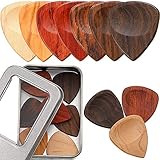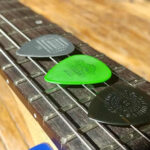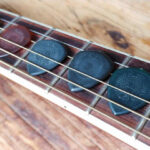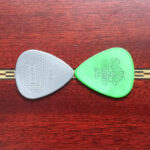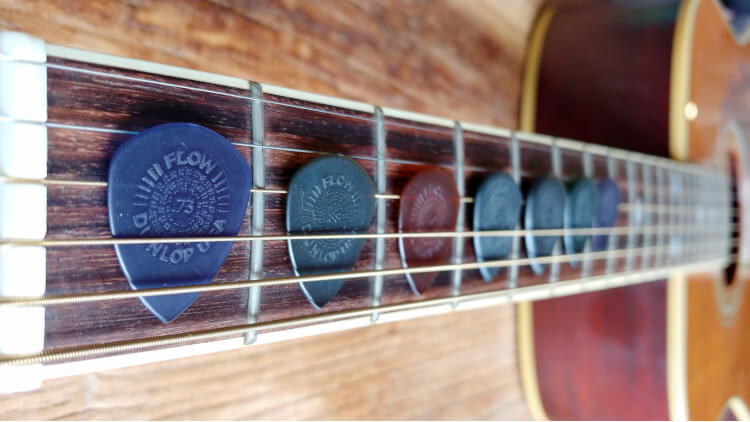
Guitar picks may be small, but they play an outsized role in sculpting a guitarist’s tone. The thickness and material, as well as technique, all contribute to the guitar’s unique sound.
The choice of material is almost limitless, from the earliest days of stringed instruments when quills were used to pluck the strings, which led to tortoise shell and the first plastic, Celluloid; and continued into a wider array of high-tech compounds.
Picks made from Tortex, celluloid and nylon now dominate today’s guitar pick sales, according to a survey of more than 300 retailers conducted in 2019 by Musical Merchandise Review:
- Tortex (34.6%)
- Celluloid (32.6%)
- Nylon (25.9%)
- Delrin (4.7%)
- Ultex (2.3%)
- Wood (0.9%)
- Metal (0.5%)
These different materials exhibit their own combinations of flexibility and strength.
The general advice from manufacturers is that picks made from softer materials will produce a warmer tone with a soft attack, while harder materials will produce a brighter, crisper tone. The five most popular pick materials ranked from softest to hardest are: Nylon, Celluloid, Tortex/Delrin, and Ultex. (You can read more about the underlying plastic compounds at the Guitar pick durability: comparing plastics article.)
In theory, more flexible picks (such as Nylon versus Tortex) allow for playing more notes per second as there is less resistance when striking the strings. This was confirmed through testing at the Faculty of Engineering at Victoria University of Wellington, although Nylon picks also produced a less defined attack and less sustain than Tortex. However, these scientific tests also assume the same technique (such as force and angle of attack) are used between picks – in practice, guitarists will naturally make subconscious adjustments.
The thickness of the guitar pick is another variable that interacts with the hardness of the material.
“Thicker picks give a much deeper sound due to a larger fundamental than the thinner picks of the same material,” according to the Victoria University of Wellington study. “Higher harmonics are heard easier with the thinner picks as the fundamental is not as dominant.”
Tortoise shell
Very few people uses tortoise shell picks today but they’re worth mentioning given it’s the material that all other modern day picks were originally measured against.
Tortoise shell picks (actually made from the outer casing of the Atlantic hawksbill sea turtle) were hand made from shells that had been heated and flattened, producing a rare combination of flexibility and tone.
They were also prone to snapping, as well as being expensive given their inherently limited supply, , according to Will Hoover’s book Picks! Production stopped in the 1970s when the hawksbill sea turtle was recognized as an endangered species. Only an estimated 20,000 to 23,000 nesting females now survive.
A range of other materials were tried as a replacement including sole leather, ox horn, and hardened gum sap from trees, but it was celluloid that first became wildly successful as a replacement.
Celluloid guitar picks
The first synthetic plastic, cellulose nitrate – or Celluloid – provided the right combination of strength, flexibility and tone to replace tortoise shell picks.
An enterprising vacuum cleaner salesman, Luigi D’Andrea, led the revolution in the early-1920s after buying some celluloid sheets to make heart shaped decorations for the tops of powder puff boxes. His son Anthony noticed they resembled tortoise shell mandolin picks, which ultimately led to a thriving business based on the classic 351 pick shape.
Celluloid was used to make a huge array of everyday items (including knife handles, hair combs, bowls, dustpans, and toys), but it is difficult to manufacture, prone to breaking down, and highly flammable. (A July 2005 fire at a D’Andrea plant in Allentown, Pennsylvania, was thought to be caused by celluloid catching alight.)
Celluloid is harder than nylon picks but softer than newer plastics such as Tortex and Ultex (some guitarists will notice the edge of their celluloid pick frays easily). It provides a middle ground and, combined with its low cost, maintains its place as an endearingly popular choice for guitarists.
Tortex
Tortex picks, launched in 1981 and instantly recognisable by its iconic turtle logo, is Dunlop’s proprietary form of acetal plastic compound (which is more commonly marketed as Delrin). The rainbow color-coding system with precise gauges printed on each pick was ground-breaking for its time, and followed a similar scheme that company founder Jim Dunlop started with Nylon picks (which had a grey colour coding scale).
Dunlop’s original goal with Tortex was to create “a pick with a bright and snappy attack, superior memory and durability, and an improved grip”. It took a year of testing before Jim Dunlop perfected the special treatment process, which produces a matte surface, giving these durable picks their particular grip and feel.
Guitarist Wendy Melvoin told Guitar Player magazine in April 1999, that she prefers Tortex picks for their durability compared to celluloid: “I use Tortex medium picks as much as I can, because if I end up with something like a Fender medium, I’ll just shred it after ten seconds of playing.”
Tortex picks are now so popular they come in at least 11 different shapes (as well as the more recent Flow shape), which is more than any other pick in the Dunlop range. However, the standard shape in the table is still most commonly used by guitarists.
Table 1: Guitarists who use Dunlop Tortex picks










Nylon guitar picks
Demand for guitar picks skyrocketed in the mid-1960s as the rising popularity of The Beatles and Bob Dylan’s electric foray inspired a new breed of guitarists. Picks were still largely made from celluloid – a plastic that required expensive equipment and was time-consuming to produce.
Pick manufacturer Herco (later acquired by Dunlop) saw an opportunity, launching picks made from Nylon – a material that was more durable than celluloid, easier to handle, and simpler to manufacture.
Herco’s first two Nylon picks were the No. 210 light-gauge Gold Flex 50 and the No. 211 heavy-gauge Silver Flex 75 in the classic standard shape with a grip design. It wasn’t long before it launched its Flexylon range of picks, also made from Nylon.
Nylon picks quickly gained popularity for their flexible feel and warm sound with some of the world’s best guitarists using them over the years, including Jimmy Page, Joe Walsh, Scott Gorham and Brian Robertson (of Thin Lizzy), Pete Townsend, David Gilmour, Don Felder, Tommy Bolin, Rory Gallagher, and Gary Moore. The Edge from U2 has used Herdim Blue Nylon picks throughout his career.
In 2012, Joe Bonamassa told Guitar Player magazine he had switched to nylon picks. “I had been using red Dunlop Jazz IIIs for years, and they have been nice enough to put my name on them. Recently, Dunlop made a run of them in gold Herco Nylon that is fantastic. I told Jimmy Dunlop he created a monster because I can’t use the red ones anymore. The Hercos are a little more pliable. You can just do anything with them.”
Delrin
Delrin is a brand name of acetal, which is the same plastic compound used to make Tortex picks. However, Delrin usually has a shiny surface compared to Tortex’s matte finish. (However, D’Andrea’s Delrex pick range, which are also made from Delrin, have a matte finish like Tortex.) This gives it a slicker release when hitting the strings. Many Delrin picks also have a beveled edge which helps with the release.
One of the few scientific studies on picks used Dunlop’s Delrin brand picks, comparing the sound produced by thin (0.46mm), medium (0.96mm) and heavy (2.00mm) picks. It found thin picks tend to produce a brighter and thinner sound compared to thicker picks when striking wound strings.
Ultex
Ultex is Dunlop’s proprietary name for the Ultem (polyetherimide or PEI) plastic compound. Ultem, which was created in the 1980s, is one of the few resins approved for use in the commercial aerospace sector thanks to its ability to not deform or degrade under repeated mechanical stress.
The combination of such a hard material with a beveled edge allows for accurate and strong picking. Keith Urban has a D’Adddario Signature Ultem pick (which has three distinct surfaces for different tonal approaches – not unlike the way The Edge uses his nylon pick).
Metal
Metal picks are a niche area: they are so hard, many guitarists find them unplayable. However, some notable names have used metal picks over the years including Eddie Van Halen (who suspected holding brass-copper picks in his mouth may have contributed to his mouth cancer).
Queen’s Brian May famously uses an old English six pence as a pick. The hardness of the coin’s metal surface is offset by May’s particularly loose grip, which provides the ‘give’ needed. ZZ Top’s Billy Gibbons is another guitarist who used a metal pick in the form of a flattened Mexican peso for many years.
Wood
Wooden picks hold a similar niche market position as metal picks, but are at the other end of the sonic spectrum. They produce a warmer sound than picks made from various plastic compounds and have found some proponents among folk and jazz guitarists. Legendary jazz guitar player John Schofield is apparently a fan of the Tree Picks brand, although he lists the thick Dunlop Delrin 2mm picks as his preferred choice on his website. Wood is almost certainly the least strongest material to make a pick from compared to plastic compounds and metal.















